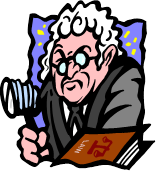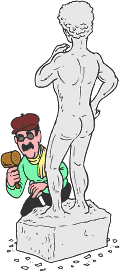
How to Find the Law that Controls
Introduction
In 1986 the internet was the exclusive domain of geek experimenters.
It wasn’t until 1991 that the “web” as we know it went public.
Yahoo® first appeared in 1994.
Google® didn’t get started until 1996.
Jurisdictionary® followed in 1997.
When I started my law practice back in 1986, legal research was mostly done digging in law libraries for citations to cases and statutes, volume by painstaking volume, the way it was when Abe Lincoln was still a lawyer 130 years earlier, using law books … the old-fashioned way.
Electronic resources for legal research were rare in those days.
My law school library and a few modern courthouse libraries in the larger cities (like Tampa and Miami) had “terminals” connected to Westlaw and Lexis. The giant law firms had terminals, of course, but a terminal in those days cost several thousand dollars, and subscriptions to electronic databases added several hundred more in monthly fees.
So, when I couldn’t beat the crowd to use a law library terminal, I was forced to dig through dusty pages of old books with names like American Jurisprudence, Federal Supplement, Corpus Juris Secundum, United States Code Service, American Law Review, etc. Each of these is actually a “set” of books, some numbering more than 100 volumes and several having further editions, e.g., Southern Reporter, Southern Reported 2d, Southern Reporter 3d, etc.
Lots of books.
Lots of page-turning.
And, hundreds of hours of mind-numbing, time-consuming jumping from one volume to another, pulling ponderous piles of books from stacks of shelves, arranging them all (open to pertinent pages or stuffed with sticky notes to mark the trail) on tables, chairs, and even the floor … a strenuous search to find the appellate courts’ official positions on issues that would mean the difference between winning or losing my clients’ cases.

All this tedious work just to discover how the controlling appellate courts might apply some particular legal principle to a particular set of facts.
If you’ve never visited a law library, it’s an eye-opening experience and highly recommended if for no other reason than for you to see, first-hand, how many thousands of books are required to contain the law for even a small part of our nation. Most local libraries include sets of books to cover only a single state or region. Only libraries at the largest law schools, the United States Courts of Appeal, or the United States Supreme Court contain complete sets of volumes necessary to research the applicable law in all federal courts and all state courts.
In Abe Lincoln’s day, a fairly complete library would require no more than a single shelf and could be purchased at a fairly reasonable price.
By 1986, even a basic law library required hundreds of books and cost tens of thousands of dollars. Each book required regular updates to keep current with new laws and case reports coming out every day! This meant subscription costs for little paperback booklets called “pocket parts” that slipped into cardboard “pockets” glued inside the back cover of each volume needing updates. Without the latest pocket parts, the reference you were relying on wasn’t up-to-date.
If your opponent cites more recent legal authorities on an issue when you get to court, you lose!
The book system was never up-to-date. By the time new law was type-set, printed, and shipped out, it was already old news. Even pocket parts couldn’t keep up.
To make matters worse for book-bound researchers, the rate at which new law is released doubles every ten years or so. There’s no relief in sight. Not only does population grow exponentially, and the popularity of litigation increase at a frightening rate, but lawmakers seem intent on adding legislation that reaches into every nook and cranny of our lives further increasing the growth of law in general.
A century ago, a few dozen appellate cases might be reported each week nationwide. Today, many thousands of cases are reported every week by appellate courts nationwide, making it impossible to keep up using a research system tied to paper.
If recency is important to winning in court, a faster legal research method is needed.
Case Law
When an appellate opinion is published in response to routine issues raised by routine cases, appellate justices seldom go into much detail why they agree or disagree with the trial judge, rarely running to more than a few paragraphs. Many affirming opinions say nothing more than “affirmed” or “per curiam affirmed” or even simply “PCA”.
But, when issues are unique or of great interest, published appellate court opinions may run to many dozens of pages, depending on the novelty or public importance of the outcome.
This is the basis of what we call “case law”, written published opinions of appellate justices.
An issue that has been discussed and explained in a published appellate court decision is said to be “stare decisis“, from the Latin to “stand decided”, meaning simply that court’s opinion is firmly settled and those of us involved in litigation may rely upon it fully to control lower court judges.
Opinions of appellate courts control all trial level judges in the same jurisdiction.
Written opinions are helpful to other parties in other cases. They clarify the law that will thereafter control the proceedings in other cases where the facts or legal arguments are the same or strikingly similar. These written opinions are regularly published online and in printed volumes generally called reporters. By researching these opinions one may find cases where the appellate court has agreed with you, and you can use those opinions to control your trial judge by citing them and making clear to the trial judge that failure to agree with you and the prior appellate court decisions that control him will result in your appealing the very same court that has already agreed with you on the issue!
That’s a big part of how you win at the trial level.
Today’s Technology
You may be reading this on a portable tablet or smart phone.
If you’re using a laptop computer, you’re behind the times.
If you’re using an old desktop computer, you’re really behind the times!
Technology brings us many rewards and ever races ahead to new developments.
For your legal research needs, there’s no more tedious digging through piles of dusty books, no more trips to a law library.
You can access the law for every state and federal court right from your current device online.
If you had to learn this course from a dusty old book, you’d have no video clips, no audio clips, no hyperlinked references, no online quizzes, and none the other cool stuff included here.
There’d be no affordable way for us to keep the course up-to-date and make timely revisions.
Technology brings us the same advantages with online legal research.
Thoroughness and recency are all important!
So, savvy litigators these days subscribe to one or more online legal research resources at a mere fraction of the burdensome cost of maintaining even a limited library of official volumes.
Westlaw and Lexis are the leading legal research providers on the internet and the most reliable. Others include FastCase and Loislaw.
In less time than it takes to locate the paper-bound volume you need at a law library and turn to the proper page to find a case on-point to help you persuade a trial judge to rule in your favor, you can log-on to any of several web-based legal research sites and find several dozen cases that fit your needs exactly!
With online research sites, finding a case is simplicity itself.
To begin, you can use Boolean Operators to search. This makes finding what you seek as easy as putting together a frame of terms assembled to zone-in on what you’re after.
The following table shows operators and samples illustrating how Boolean Operators work.
| Operator | Sample | Explanation |
| AND or & | boy AND girl | Finds only results including both boy and girl. |
| OR | boy OR girl | Finds only results with either boy or girl but not both. |
| NOT | NOT girl | Finds only results that do not contain girl. |
| w/8 or /8 | boy /8 girl | Finds only results having boy within 8 words of girl. |
| * | boy* | Finds all results with boy, boyd, boyle, etc. |
| ” … “ | “boy and girl” | Finds only results with exactly “boy and girl”. |
| ( ) | boy OR (girl & baby) | Finds all results with boy or with both girl and baby. |
This video clip shows how to find the elements for a cause of action within published appellate court opinions. Click the movie projector now: 
Everything of value in your search for controlling law to keep the judge in your case from having a free hand to rule however he wishes is available online.
When on-line legal research first became available, we had to connect to expensive legal databases costing hundreds of dollars every month for subscription fees. Westlaw and Lexis were the leaders, and only the most successful lawyers could afford either.
Most of us still had to laboriously dig our legal research from books … and it was hard slugging!
If you didn’t have a nearby courthouse law library or an extra $30,000 or more to purchase your own set of legal reference books (and the expensive “pocket parts” updates publishers sent to keep their paper-bound books up-to-date with the latest cases and legislative developments … well … you were pretty much out of luck.
Some lawyers were faced with “winging it” with guesswork, (those of us who weren’t born with silver spoons in our mouths).
We’ll show you easy ways to find official legal authority you need to control trial judges so you can get favorable judgments.
You cannot hope to win without legal authority.
Clever argument is not enough.
Having all the facts is not enough.
You must cite to controlling appellate case law in your motions, memoranda, and verbal presentations at hearings and at trial.
You must instruct the judge on the controlling law, explaining why you should win by citing official legal authorities the judge is required to obey: court rules, cases, constitutional provisions, statutes and codes.
Without citations to legal authority on the record in your case, you cannot control the trial judge nor win on appeal … if appeal becomes necessary.
In the Citations class in this course you’ll learn proper format for citing legal authorities, e.g., Jones v. Smith, 286 U.S. 85 (1997).
Knowing how to find and cite controlling legal authorities is critical to winning lawsuits.
Your opponent will certainly cite to official legal authorities favoring his case.
Count on it.
You must do the same … if you want to win.
But, if you’ve wandered through a law library in search of legal authority, you were probably amazed to find crowded shelves stuffed with volumes of similar-looking books differing only by the mysterious numbers printed on their spines. Books that gave no hint which one might hide the key you need to unlock the judge’s favor in your case. In an average well-stocked law library there may be thousands of books like these. You can’t read them all to find what you seek.
On the other hand, if you’ve tried any legal research on the internet, you’ve probably discovered that cheap or free resources can’t be trusted (because they are incomplete or inaccurate) and expensive ones cost too much to use.
 Bad Judges
Bad Judges
Judges have egos, personal opinions, and biases.
On rare occasions you might bump into one who’s in some powerful bigshot’s pocket, ruling for the party who pays the most graft, but more often you’ll be dealing with an ordinary human being who just happens to have a malady lawyers call “black robe disease” (proclivity to ignore The Rule of Law and enter orders based on their ego, personal opinion, or bias).
We at Jurisdictionary® are aware of angry groups on the internet calling themselves “patriots”, complaining about judicial improprieties (without offering any workable solutions to the problem) and we are sympathetic with those who’ve been railroaded or sold down the river by judges who were derelict in their duty or downright dishonest.
Our viewpoint is different, however.
You must prepare for appeal at all stages of your lawsuit, because by preparing for appeal you reduce the chances you’ll be required to appeal. Making a strong record for appeal warns the trial judge he will be overturned on appeal if he rules against you.
Rather than complaining of the proclivity of those judges who violate the law in the name of the law, we teach you how to control bad judges by putting legal authority in the record and demanding judicial compliance. We teach you to draft effective pleadings, discover evidence, move the court to enter winning orders, and make a record for appeal, but for this to work one must present legal authority the judge is required to obey or be overturned on appeal!
How to draft effective pleadings, discover evidence, and move the court is explained in other tutorials in this course.
Of course, to cite controlling appellate opinions in your case, you must find them first.
This is what legal research is for: Finding controlling official appellate case law that controls trial judges.
You want to put the judge in a box that allows only one result – victory!
To do that, of course, we must know how to use the law library and on-line research tools. Law libraries aren’t all that daunting once you know the fundamentals of how the printed materials are organized, how to focus in on what you need. As for on-line legal research, if you can afford the best resources (Westlaw or Lexis) by all means use them, but in this class we will show you how to use other, less expensive resources and how to double-check on-line authorities before citing them in your case.
Of course, before we can begin we must know what we’re looking for.
All this and more is explained in the pages that follow along with tips and tactics you can use to quickly, accurately, and inexpensively find what you need.
Legal research can be fun. It’s like an Easter egg hunt, but with a far more valuable prize. Telling a recalcitrant judge he has no choice but to rule in your favor is one of the most enjoyable things a human being can do … especially when it means a large sum of money in your pocket!
Good judges welcome this. They want you to tell them the law that justifies their rulings. It protects them. They see from your effective research that the appellate court above them won’t reverse or remand their decision if they follow the ruling of the higher tribunal. You give a good judge the law, and the judge will give you what you want.
Bad judges, on the other hand, don’t like to be told what to do. But! It’s their job to do what’s right, like it or not! And, it’s your job to tell them what legal authorities require the judgment you seek. If there’s any wiggle room at all in the legal research you provide to a bad judge, he will find a hole in your argument and rule against you if he has a mind to do so. Do your research well, however (if your case merits a successful outcome) and you put the judge in a box. He must rule in your favor or suffer the embarrassment of being overruled by a higher court when you appeal. Judges hate to be appealed. It makes them look stupid (or reveals the corruption at their core). The encouraging thing about all this is that the better your work at the trial level (good judge or bad) the less likely you’ll receive an adverse ruling that needs an appeal.
Doing things right the first time has great value.
That’s why in this class we’re going to teach you how easy it is to find the legal authorities that (1) control your trial judge and (2), if an appeal is necessary to persuade the appellate court to overrule the trial judge.
Classifying Legal Resources
As we begin this fascinating exploration of the world of recorded law, tell yourself right now, “There’s an easy way to do this effectively.”
The process we call legal research is easy once you see how legal resources are organized. Imagine walking into a disorganized kitchen to prepare a lovely lamb stew only to find spices, pots, pans, utensils, and measuring tools tossed haphazardly into drawers and cabinets with no sense of organization! Fortunately for us, legal resources are organized, just like an efficient modern kitchen. What you want is where it ought to be. Each tool has its own unique place in the organization. There are even indexes to help you find what you’re seeking … once you understand the various types of resource materials and what each offers.
Whether you work with printed materials in a law library or surfing the internet, it’s essential to know how to classify legal resources, how they differ, their weaknesses and their strengths … printed or on-line.
Approved on-line research sites:
Westlaw.com
Lexis.com
Loislaw.com
FastCase.com
The thousands of books in a law library can be organized into a very few categories. Knowing the categories is essential to successful legal research, whether you have access to reliable on-line legal search tools or plan to dig through the shelves at the law library. Once you understand the types of resources available (print as well as on-line) and know what you’re looking for, the process of legal research is simple. Good library researchers can go straight to the books and find case-winning citations. With on-line tools, research is more like a child’s video game.
The key is understanding the “types” of research tools and how to use each to find the law you’re looking for.
The following categories include the majority of legal resources.
- Reporters
- Digests
- Statutes … Basic or Annotated
- Supplements
- Texts
Reporters are compilations of cases decided by appellate courts. Included are federal reporters, regional reporters, state reporters, bankruptcy reporters, military justice reporters, U.S. Supreme Court reporters, U.S. Claims Court reporters, and more.
Digests include American Digest, Supreme Court Digest, Federal Practice Digest, and Bankruptcy Digest, among others.
Legislative law includes codes, statutes, annotated statutes, ordinances, evidence rules, and more.
Texts, of course, cover all areas of legal and factual information likely to be of use to litigators. Many can be found in your local county or city library.
 Getting Started
Getting Started
Batter up!
Get ready to win.
But, first you’ve got to hit the ball … hard!
You’ve got to knock it out of the park, overcome your opponent with rock-solid law he can’t refute, law that demands the outcome you deserve, law that’s crystal clear, on-point, and up-to-date.
Where is it?
Well, the first step in finding the law is deciding what law we’re looking for.
The next step is to write down what we decide. Make a list. Put it in words. Don’t start wandering around the law library aimlessly or begin clicking your mouse on the first legal research website you find in hope of discovering that “just right” case or statute. Do the work. Take up your pen or pencil. Grab a fresh, unused notebook, and start writing.
Answer these four questions before you begin … write your answers down!
- What am I looking for?
- What sort of legal authority is it?
- What will it say?
- How will it help my case?
Types of Legal Authorities
All legal authorities are “written decisions on issues of law”.
There are effectively only four type of authorities.
- Constitutions
- Statutes or Code
- Court Rules
- Case Law
Whether the authority is a constitution, a statute or code, a court rule, or an appellate court opinion, it is a “written decision on an issue of law”.
That’s what we want … written decisions on issues of law.
That’s what all legal authorities are … written decisions on issues of law.
Constitutions (the United States Constitution and constitutions of the various states) are all written decisions on issues of law related to the scope and powers of government. In general they supercede statutory authority, rules, and case law (subject to court interpretation).
Rules (e.g., rules of civil procedure, rules of evidence, etc.) are written decisions on issues of law related to what takes place in our courts and legislative bodies. They, too, are subject to court interpretation and limitations.
Statutes (also called code) are compilations of “law” assembled in an orderly way (since session laws are enacted in a serial fashion, one after the other, without regard for any particular organization) that control everything from ice cream manufacturing to the sale and installation of fire extinguishers or the number of chickens you can fit in a pot.
Statutes form the underlying basis for many lawsuits. However! Though a code or statute may seem crystal clear to you, it is essential for you to find (if you can) cases decided by a court with authority over your trial judge that sees the statute as you do. The written decision of appellate courts is final authority on what statutes “mean”.
Appellate court decisions (also known as case law) are the power you use to force a recalcitrant judge to agree with you about constitutions, rules, and statutes or code. Your opinion will, in the long run, prove valueless. The written opinion of a court sitting above your trial judge (when that opinion agrees with your opinion) is golden.
If case law is from a court outside your jurisdiction, it might still persuade your trial judge to rule the way you want. It might not be controlling, but if there are no conflicting decisions in courts above your trial court (nor any conflicting federal decisions) then the non-binding foreign decision might persuade your trial court judge that ruling against you and the foreign court could result in his decision being overturned on appeal.
Judges hate being appealed!
Appeal is how “We the People” keep our trial judges in line.
Appeal is how we change bad statutory laws.
Appeal is what we do to make the world safer for “the little guy”.
But, appeal is impossible unless proper procedure and effective legal research and citation practice is followed at the trial court level.
In general, the following decisional hierarchies are obeyed.
State Court Decisional Hierarchy
- United States Supreme Court
- The State Supreme Court
- The State Appellate Court
- The Trial Court
Federal Court Decisional Hierarchy
- United States Supreme Court
- United States Circuit Court of Appeals
- United States District Court
This generalized list is offered to give you a basic idea of the hierarchy of court authorities. In the federal scheme there are tax courts, admiralty courts, military courts, and other tribunals, but in general there are only the three levels beginning with the “court of first impression” at the District Court. State court hierarchies may similarly differ, but in general the hierarchy shown here is typical throughout the States.
Of course at the top of the heap is the United States Supreme Court and its nine justices that sit on that imposing bench in our Capitol City. Decisions of the Supreme Court must be followed by all lesser courts – federal and state. Nine men and women decide what is and what is not “Constitutional”. Of late the Supreme Court has gone beyond merely ruling on constitutionality of legal issues, making excursions into the realm of moral pontification. Supreme Court decisions go far beyond constitutionality, reaching into every crack and crevice of our daily lives. The highest court’s decisions control the state court judge in your case. If you can find a Supreme Court decision on-point (i.e., that applies directly to the facts in your case), your victory is assured.
Roe v. Wade is one of the more salient, or should we say sanguine examples of judicial activism.
At the other end of the spectrum are the trial courts, where most cases originate.
In the federal system the bottom of the totem pole is the U.S. District Court for the federal district where you live. This is the “trial court” for federal cases. For example, if you live in Miami or Fort Lauderdale your federal case would begin in the U.S. District Court for the Southern District of Florida.
If your federal case is appealed it goes to the U.S. Circuit Court of Appeals that is over the several district courts in the district court’s jurisdiction.
If you aren’t happy with a decision at the U.S. Circuit Court you might appeal to the U.S. Supreme Court, but chances of having a case heard in Washington are slim to none. Only the most important cases are heard by The Supremes. In most cases if you lose your appeal at a Circuit Court of Appeals you have lost completely. End game.
Exceptions include cases that begin in county court or small claims court and are appealed to the local circuit court, by whatever name it may be known. In some states the trial court level is called Superior Court. In others it’s called Circuit Court. Whatever the name, it is the case of first resort, i.e., where the case is begun.
A similar hierarchy exists in state courts where there’s always a trial court to begin the case. Generally, appeals from a trial court are taken to the state appellate court that commands the trial court. Appeals from a state appellate court may be filed with the state supreme court in special cases (e.g., where one appellate court decision differs materially from the decision of one of its sister appellate courts so there is conflict between the two that needs to be resolved by the state supreme court), but very few cases get to the state supreme courts. And, it is only in the rarest of instances that a state court decision at any level will find its way to the U.S. Supreme Court bench in Washington.
Statutes or Code
If and only if a statute has never been interpreted by an appellate court decision on the fact issue material to your case, the statute standing alone may be a controlling legal authority. In reality, nearly every statute (state or federal) has at least some case law opinions written to explain the scope and authority of the statute, limiting or expanding it beyond the four corners of the statute itself. The only way to “interpret” a statute, therefore, is to see how the appellate courts interpret it. Later in this class we’ll show you how to find case law that interprets statutes or code and how to find opinions that apply to statutory issues in your case.
Armed with a statute and case law that interprets the statute, you have weaponry to reign in the judicial ego ruling on your case by requiring him to follow the law.
Constitutions
Though state constitutions and the United States Constitution are legal authorities the trial judge in your case must follow, they are like statutes and code in the sense that their provisions are interpreted by case law. To merely cite a constitutional provision without citing at least one good case that supports “your view” of what the provision means is a sure way to shoot yourself in the foot. Perhaps the judge has a different view of what the provision means. If you have one view, and the judge has another view, guess who wins! On the other hand, if your view agrees with the view of a published appellate or supreme court decision on the matter, the judge must go along with the legal authorities you cite and rule the way you want … like it or not.
Rules
The fourth and final category of controlling authority is the relatively simple set of rules that control procedure and presentation and admission of evidence. Court rules, too, are interpreted by case law. So, once again, though you read a rule to say a certain thing favorable to your cause, the judge may read it differently. Never rely on your own view of the law when reading legal authorities. Cite appellate decisions that agree with you, case law that controls the trial judge.
Only if you cannot find any higher authority in case law should you attempt to offer your own opinion as to what a rule, statute, or constitutional provision means. In almost all cases you will find higher authority you can cite.
Secondary Sources
Other resources, though not “controlling”, may influence a court in your favor where there are no conflicting legal authorities. Examples are restatements of the American Law Institute (ALI), law school textbooks (horn books and nutshells), and law review articles. The more prestigious the authors of these resources, the more likely it is that the judge in your case will be persuaded to the views expressed.
The American Law Institute is an independent body of scholars who publish books called restatements in various areas of law including Agency, Contracts, Property, Torts, and Trusts, among others. For more information, visit their website at www.ali.org
Such secondary sources, however, can never trump controlling case law opinions of an appellate court above the trial court in the hierarchy of court power. As we said earlier, the opinion of a court in Oregon might tend to influence the decision of a trial court judge in Florida, but it will not trump an opinion of our Florida Supreme Court nor an opinion of the District Court of Appeal that’s directly above the trial court in hierarchical power. Foreign state court opinions, like law review articles and law school textbooks, are only advisory. They are not controlling.
Summary
From the foregoing you’ve seen that although rules, constitutions, statutes and code are controlling authorities, by far the most powerful authorities are written opinions of appellate courts directly above your trial court in the hierarchy of judicial power. Courts of first impression must answer to courts of last impression.
That’s how our system works!
Of course, neither a trial judge nor an appellate panel, not even the United States Supreme Court, can abrogate or overturn any provision of the United States Constitution.
Nor can any state court, not even the state’s highest court, abrogate or overturn any provision of that state’s constitution. The courts’ may interpret constitutions, but they cannot change them. Only the People can do that.
Courts can, however, change rules and statutes.
They can even overturn, reverse, remand, and overrule each other.
Make no mistake. It is the courts that run this nation of states. They do it by writing appellate decisions on issues of law, interpreting constitutions, statutes, and rules.
We may begin our research with a statute, constitutional provision, or rule. But, in every case we search for cases that interpret these with written opinions the trial judge must obey. Then we “instruct” the judge, telling him the controlling legal authorities that command him to do what we want.
With this fundamental framework to begin, let’s get started.
The Law Library
Whether you’re going to do your legal research on the internet or planning to dig for legal gold in your local law library, the place to start your education is by understanding what’s available in print.
Almost everything on the internet is also printed in a book or set of books. Though it’s far easier to find what you’re looking for with a mouse and computer, it’s nonetheless essential to know the types of resources that can lead you to the authorities you seek. Web-based services are by far the easiest to use, but if you don’t understand how the law is organized and what avenues are open for high-speed access to the exact citation you need, you could spend weeks on the internet and fail to come up with anything truly useful.
Therefore, this chapter is devoted to a brief overview of the types of printed volumes you’ll find in most law libraries and how your understanding the organization of printed resources can speed you in your electronic quest on the websites. You may even find you enjoy digging through the dusty shelves, pulling down books you can hold in your hands, and hiding away in a library cubicle to read from a printed page instead of a glaring CRT or LCD screen.
If your finances are too limited to pay for full-powered on-line research, a wealth of information is FREE at your local law library, and it isn’t too hard to find once you know a few of the tricks and tips we offer later in this class.
For now let’s discuss the types of resources available in print.
In general, all legal resources are classified in two main groups.
- Primary Sources
- Secondary Sources
Primary Sources
Primary sources include:
- Constitutions
- Rules
- Statutes and Session Laws
- Statutes Annotated
- Case Digests
Statutes
Statutes are primarily what we call “substantive law” that controls what we do, what we eat, what we sell and how we sell it, which side of the road we drive on, how much tax we pay, etc. This is opposed to “procedural law” that controls what happens in our courts and legislative bodies, law that determines how long a defendant has to respond to a lawsuit or how many interrogatories can be served.
Interrogatories and other aspects of legal procedure are explained in other tutorials in this course.
As taught in our other Jurisdictionary® materials, there are procedural rules and rules of evidence, then there is the almost limitless body of legal knowledge we know as “substantive law”. These are found in statutes and codes, law related to matters such as insurance, drug manufacturing regulations, building codes, even speed limits.
Secondary Sources
Secondary sources include:
- American Jurisprudence
- Commentaries
- Textbooks
- Practice Guides
- Form Books
- Words & Phrases
- Law Review
- Hornbooks and other law school textbooks
- Case books used in law schools
- Nutshells
- Outlines
- Newspapers and Magazines
Is there a simple system you can use to find what you need in those big, thick books?
Are there alternatives to the expensive on-line services?
Are you even certain what legal authorities you’re looking for?
Where do you begin?
Substantive law falls primarily into one of the following four categories:
- Constitutions
- Rules
- Statutes and Code
- Case Law
In practice, it is seldom you will resort to constitutional law – although many pro se people (i.e., people without lawyers) make the mistake of storming into court with the powerless argument, “My constitutional rights have been violated!” This is never the best way to proceed.
The better way is to rely on case law and statutes (we’ll use that word to include both statutes and administrative code, i.e., substantive laws created by legislative acts or the declarations of various government administrative bodies) to present the court with legal arguments why you should win your case … whether you’re a plaintiff or defendant.
As I write this class for you, I sit in the law library at my local courthouse, surrounded by literally thousands of imposing books. To the uninitiated the vast volume of writings can be downright intimidating. That’s why we’ve created this class (in the tradition of our other tutorials) to make legal research ridiculously easy to understand.
Finding the law is a search, much like solving a mystery. You have a few clues. You have the facts. Perhaps you have an idea about what laws apply. Your goal, however, is to discover rules and laws (remember that Jurisdictionary® differentiates these) that will control the judge.
Judges (at least at the preliminary trial level) are not empowered to “create” law. They are in all cases controlled by existing law – at least where there is existing law that applies to the particular fact situation before them in the case. If you can find the law that controls the trial level judge, and that law is on your side, then you control the court!
If you simply wander into court with the vague argument, “My constitutional rights have been violated,” without being able to call the judge’s attention to some rule, statute, or controlling opinion of an appellate court, you lay yourself open to defeat.
Judges, like the rest of us in this life, are subject to some “higher authority”. Even the United States Supreme Court is subject to the power of the Senate (though, of course, the Senate has elected to use that power far too sparingly), and the Senate itself is subject to the will of the people … who, in turn, are ultimately responsible to the will of Almighty God who determines the destiny of us all in accordance with the acts and decisions we make. A judge cannot merely rule one way or the other because he or she “feels like it” (unless you allow them to do so by failing to point out the law that controls them). All judges (at the initial trial level, especially) are subject to controlling statutes and opinions of the appellate courts above them.
This is what we search for when we visit the law library or go on-line to use one of the computer-based legal research tools.
So, having said all that, let the search begin.
Reporters
There are reporters who interview soccer players and other sports figures, but those are not the kind of reporters we’re interested in this class.
Reporters are books containing written opinions of appellate courts,
and courts of last resort, without any particular organization to help you find the case you need.
For example, West’s Supreme Court Reporter contains all the published decisions of the United States Supreme Court going back to day one. United States Reports are official versions from the U.S. Supreme Court.
Cases published in reporters often have “helps” at the beginning of published opinions to give you a quick idea what the case is about without reading the entire case. These helps are called “headnotes”, but they are not reliable. Always read the entire case if the issue you’re searching for is critical.
 Statutes Annotated
Statutes Annotated
Statutes are not statues.
Don’t misspell the two words.
Annotated statutes are statutes (or code) that have references to written appellate court opinions that have interpreted how the statutes can be applied in various fact situations.
Sets of annotated statute books and annotated code exist for all state and federal court jurisdictions.
For example, for federal statutes (code) there is West’s United States Code Annotated (USCA) and Lexis’ United States Code Service (USCS).
These are the most common sets of annotated statutes for federal courts. Each differs in some regards from the other, but both provide citations to case law relevant to various aspects of statutes that may apply in your case.
For example, on the effect of invoking one’s Fifth Amendment privilege or asking for a lawyer while in police custody, USCS gives more than a dozen cases explaining the legal effect of such an invocation of the Fifth Amendment or request for counsel. For each case cited, a brief synopsis is given to explain what the case says – so you can select cases that most closely relate to the fact situation for which you’re researching.
USCA and USCS give you hooks to get deeper into the effect of federal statutes on the cases you’re litigating.
Supplemental Resources
Proof of Facts
A valuable tool for determining what needs to be proved to win a case, and how to go about proving it, is a set of books under the American Jurisprudence label entitled Proof of Facts, now in its 3rd series.
Like others this set has its own index that is updated on a regular basis, giving you hooks to find the materials you need.
For example, in the index under “Products Liability” we find an entry for foreign substances in food or beverages. The index tells us the information we need is at 30 POF2d 1, so we go to volume 30 of the 2nd series of Proof of Facts and turn to page 1 where we find a 93-page treatise on the issue, “Whether there was a foreign body or substance in a food or beverage that was consumed or partially consumed by a person and caused illness or injury.”
Proof of Facts is published by
Lawyers Co-operative Publishing Co., Rochester, New York 14694.
There is then provided an outline of the issue with citations to legal authorities and secondary sources to support your argument and proof (if you’re a plaintiff who suffered damages from ingesting a foreign substance while eating or drinking something provided by the defendant in your case).
Included in the outline are the following subjects and attendant references.
- What are “foreign” substances in a food or beverage.
- Negligence as basis of liability.
- Duty of care.
- Effect of statutory provisions.
- Warranty as basis of liability.
- Strict liability in tort.
- Identification of defendants.
- Proving presence of foreign substance.
- Proximate causation; proof.
- Defenses.
- Burden of proof; doctrine of res ipsa loquitur.
- Elements of damages; guide and checklist.
- Elements of proof; guide and checklist.
- Testimony.
POF provides text references and legal periodicals dealing with the issue, together with forms, trial techniques, annotations, and an exhaustive index to the subject.
And that’s just one of thousands of topics covered in detail by this useful set of reference books.
Conclusion
When doing legal research online, be cautious of unreliability.
Not all that you find on the internet is reliable. Much of it is pure junk. Junk that will get you in deep trouble if you rely on it. There is no substitute for reliability. The internet is an “open architecture” giving anyone and everyone an opportunity to publish their private views and opinions that count for absolutely nothing in court.
The best on-line resources are beyond the financial reach of most folks, and most of the less expensive on-line resources are unreliable.
Used properly, much of what’s offered on the net (expensive, cheap, or free) is excellent.
Just be certain the legal database you choose is reliable and recent.
The end of this course. Sign up for another.
